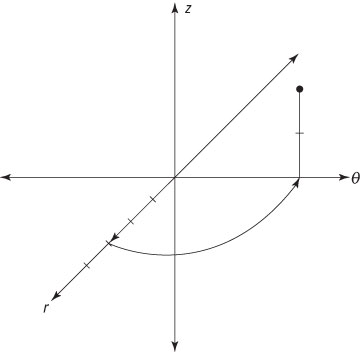Cylindrical coordinates are simply polar coordinates with the addition of a vertical z-axis extending from the origin. While a polar coordinate pair is of the form
with cylindrical coordinates, every point in space is assigned a set of coordinates of the form
The polar coordinate system assigns a pairing of values to every point on the plane. However, these values aren’t dependent on two perpendicular axes (though these axes are often drawn in to make the graph more readable). The key axis is the horizontal axis.
Here’s what you need to know:
The variable r measures the distance from the z-axis to that point.
The variable

measures angular distance from the horizontal axis. This angle is measured in radians rather than degrees, so that

The variable z measures the distance from that point to the xy-plane.
When plotting cylindrical coordinates, plot the first coordinates
just as you would for polar coordinates. Then plot the z-coordinate.

This figure shows you how to plot the point
in cylindrical coordinates:
Count 3 units to the right of the origin on the horizontal axis (as you would when plotting polar coordinates).
Travel counterclockwise along the arc of a circle until you reach the line drawn at a π/2-angle from the horizontal axis (again, as with polar coordinates).
Count 2 units above the plane and plot your point there.

